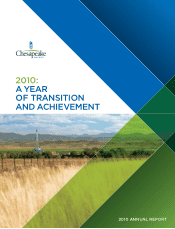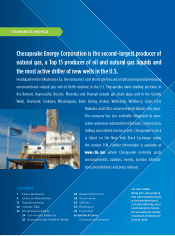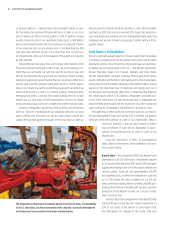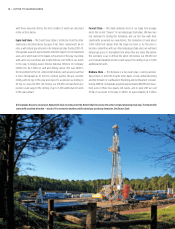Chesapeake Energy 2010 Annual Report Download - page 11
Download and view the complete annual report
Please find page 11 of the 2010 Chesapeake Energy annual report below. You can navigate through the pages in the report by either clicking on the pages listed below, or by using the keyword search tool below to find specific information within the annual report.
with these new play efforts, the most notable of which are described
in the sections below.
Eagle Ford Shale — This South Texas shale is distinctive from the other
shale plays described above because it has three components: an oil
play, a wet natural gas play and a dry natural gas play. During 2009–10,
Chesapeake acquired approximately 600,000 Eagle Ford net leasehold
acres, all of which were in the liquids-rich portions of the play. Our initial
wells were very successful, and in late 2010 we sold 33.3% of our assets
in the play to Beijing-based Chinese National Offshore Oil Company
(CNOOC) for $2.2 billion in cash and drilling carries. This was CNOOC’s
first investment in the U.S. onshore E&P industry, and we are proud that
it chose Chesapeake as its first U.S. onshore partner. We are currently
drilling with 16 rigs in this play and expect to accelerate our drilling to
40 rigs by year-end 2013. We believe our 470,000 net leasehold acre
position could support the drilling of up to 5,500 additional net wells
in the years ahead.
Pearsall Shale — This shale underlies most of our Eagle Ford acreage
and is the second “sleeper” of our natural gas shale plays. We have two
rigs dedicated to testing this formation, and our first few wells have
significantly exceeded our expectations. This formation is found about
3,000–4,000 feet deeper than the Eagle Ford and so for the play to
become competitive with our other natural gas shale plays, we will need
natural gas prices to strengthen from where they are today. We believe
this will likely occur in 2013 at the latest. We believe our 350,000 net
acre Pearsall leasehold position could support the drilling of up to 3,000
additional net wells.
Niobrara Shale — The Niobrara is a two-basin play, covering substan-
tial portions of both the Powder River Basin of east-central Wyoming
and the DJ Basin of southeastern Wyoming and northeastern Colorado.
During 2008–10, Chesapeake acquired approximately 800,000 net lease-
hold acres in these two liquids-rich basins, and in early 2011 we sold
33.3% of our assets in the play to CNOOC for approximately $1.3 billion
10 | LETTER TO SHAREHOLDERS
A Chesapeake discovery, Louisiana’s Haynesville Shale recently passed the Barnett Shale to become the nation’s largest producing shale play. The Haynesville
comes with an added attraction — much of it is overlain by another prolific natural gas-producing formation, the Bossier Shale.
























